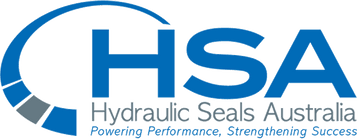Within a Hydraulic cylinder, the function each component plays is crucial to ensuring optimal performance and longevity of the cylinder. In this blog, we will look at the common Excavator piston arrangement and the role each component plays.
Most arrangements comprise of the following components.
- Double acting piston seal (A)
- Square section extrusion rings (B)
- Guide/Wear Rings (C)
- Anti-dieseling/Anti-contamination rings (D)
We can see in the picture below the layout and location of each item on the piston.

A) Double acting piston seal
This profile can vary between makes and models, however the same principals apply. This component comprises of a NBR energizer and a harder sealing cap. Most OEM seal kits will be supplied with a bronze PTFE sealing face that can be difficult to install and damage easily. At HSA we use our XSL, an extra hard, self-lubricating Polyurethane. Not only is it easy to install, it can withstand double the extrusion gap for the same pressure as regular bronze PTFE and tolerates abnormal bore conditions. This double acting seal is what controls leakage and the extension and retracting of the cylinder shaft, therefore ensuring a high quality material is crucial for success.
B) Anti-extrusion rings (AE Rings)
Originally developed to help prevent extrusion and cold flow of the PTFE cap at high pressures, these components still play a important role in helping minimize the extrusion gap allowing the piston seal to operate at higher pressures without failing. While the AE rings do provide allowance for larger extrusion gaps and pressures, there are limitations and the seals specified allowable extrusion gap must be adhered to. These AE rings can also form part of the piston seal as shown below. Made from either POM (Acetal) or PA (Nylon).
The CT-XSL is a modern profile incorporating AE rings as part of the seal design. This profile is becoming more common as the primary piston seal in excavators.
C) Guide/Wear rings
These components play a crucial role in ensuring the elimination of steel to steel contact between the piston and the bore and also keep the piston centered and running true with the bore. It is common to see poor quality guide/wear rings in OEM kits. As with the piston seal, HSA offers a product that can, and does continuously exceed that of OEM and our competitors. Our material is a synthetic fiber-reinforced polyester composite with graphite micro-powder additives that offers a very high load carrying capacity. These are also produced to tight tolerances, minimizing play which assists in increasing seal life.
D) Anti-dieseling/Anti-contamination rings
These components’ importance in the cylinder is often overlooked, yet they play a crucial role. They protect the double-acting seal from a myriad of issues, from dieseling phenomena (where air compressed by hydraulic oil explodes at high temperatures) to contamination from foreign bodies. It is important to note material choice for these components as a softer filled PTFE is more suitable with absorption of these foreign bodies.
Overlooking these items and accepting less than premium quality sealing components will have a detrimental effect on the longevity of your hydraulic cylinder. At HSA we understand quality and only provide sealing components that are trusted and proven performers in the field. In our next article we will look at common rod gland arrangements and the role each component plays in ensuring sealing performance.




